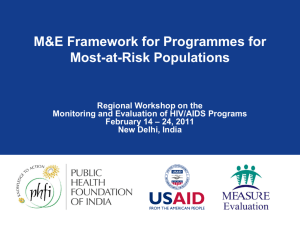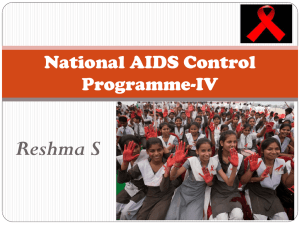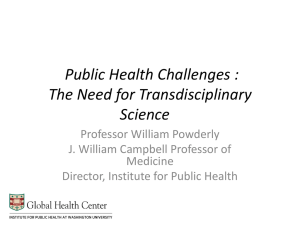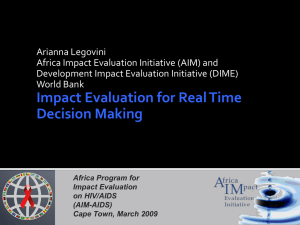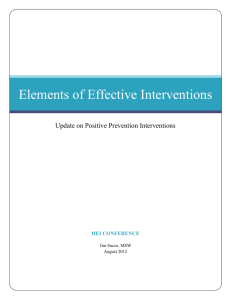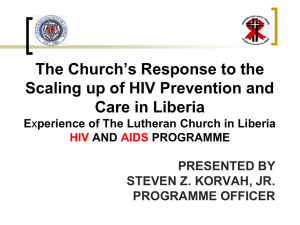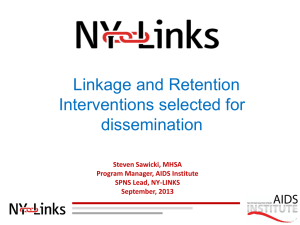Operations Research Presentation
advertisement
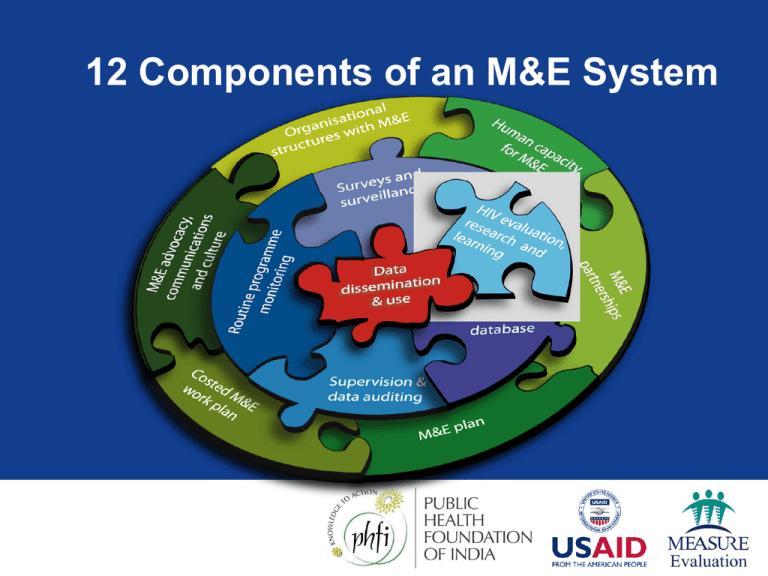
12 Components of an M&E System Introduction to Operations Research Dr. Sumit Malhotra, MD Assistant Professor, Indian Institute of Public Health, Public Health Foundation of India, New Delhi 2 Objectives of the session To understand the relevance of operations research in HIV/AIDS programs To know what OR is? What is OR cycle? To be familiar with designs commonly used in OR. HIV Prevention and Circumcision 1980s- Low prevalence of male circumcision in the parts of sub-Saharan Africa most affected by the epidemic A review of 28 observational studies in African countries concluded that circumcised men had about a 44 percent lower risk of HIV infection compared to circumcised men. Conflicting results- DHS Weak associations Religion or culture Need for Experimental studies 4 3 Trials Performed In South Africa, Orange Farm, 3,000 men aged 18 to 24; circumcised men 60 % less likely to acquire HIV than the uncircumcised men In Uganda’s Rakai District, 4,996 men aged 15 to 49, circumcision reduced the risk by 51 % In Kenya, Kisumu, 2,784 men aged 18 to 24 ; risk was reduced by 59 %. An ongoing follow-up study found that this protective effect was sustained over 42 months, reducing men’s chances of becoming infected with HIV by 64 % 5 Circumcision Introduction Framework 6 7 Operations Research SCIENCE OF BETTER Improvements 8 Definitions of OR Any research producing practically-usable knowledge (evidence, findings, information, etc) which can improve program implementation (e.g., effectiveness, efficiency, quality, access, scale-up, sustainability) regardless of the type of research (design, methodology, approach) falls within the boundaries of operations research - GF, USAID,WHO,TDR,UNAIDS & WB 9 Definitions of OR OR has its roots in military and industrial modeling discipline of applying advanced analytical methods, including mathematical models, to help make better decisions 1 1 Scope of OR Identify common implementation problems and their main determinants which prevent effective access to interventions and determine which of these problems are susceptible to research Develop practical solutions to these problems and test whether new implementation strategies based on these solutions can significantly improve access under conditions of routine disease control 1 Scope of OR Determine - in collaboration with partners – the best way to introduce these new implementation strategies into the health system and facilitate their full scale implementation, evaluation and modification, as required 1 Example- Identifying the problem Despite patients offered ARVs, OIs like diarrhea and pneumonia were high amongst them. Why are HIV positive clients experiencing poorer health outcomes? Problem of adherence to regimens. Example- Considering the reasons Poor communication between clients and staff Low income clients do not have enough money for transportation – refill their prescriptions Clients can not afford to miss their work to come to clinic Perceived stigma Frequent drug stock outs Example- Testing the solutions Drug stock outs Staff in service training to improve drug forecasting Developing clinic based performance standards that inform the basis for problem solving among staff Which solution solves problem best? Characteristics of OR- 1 It addresses specific problems within specific programs, not general health issues; It addresses those problems that are under control of managers, such as program systems, training, pricing and provision of information; 1 Characteristics of OR- 2 It requires collaboration between managers and researchers in identification of the research problem, development of the study design, implementation of the study and analysis and interpretation of results; and It succeeds only if the study results are used to make program decisions; publication alone is not a valid indicator of successful OR.” 1 OR Access Problem - Example Program Problem: How to get more adolescents to use reproductive health clinic Managerial Factors: Price, hours, provider training… Output: More visits to clinic by adolescents Outcome: More contraceptive use Impact: Fewer unwanted pregnancies 1 OR is Not Methodologically Defined Different methods used in OR studies: • Quantitative • Qualitative • Surveys • Experiments 2 Does OR in public health requires complex modeling techniques? 2 Examples Improving effectiveness of medical interventions Assessing feasibility in definite population or setting Advocating for policy change 2 Example – Improving effectiveness of medical interventions Author Study description Main Findings Policy implications Zachariah et al Payment for ARV drugs is associated with higher rate of patients lost to follow up than those offered free of charge therapy in Nairobi, Kenya 58% higher risk of loss to follow up associated with payment for ART; ART dose dilutions by patients who had to pay for ART Detrimental effect of payment based therapy on outcomes, service began free of charge in hospitals 2 Example – Assessing feasibility in definite population or setting Author Study description Bedelu et al Descriptive report of a rural model of antiretroviral treatment Main Findings Policy implications A decentralised, simplified model of antiretroviral therapy delivery based on nurses was feasible in rural South Africa Led to policy change in allowing nonphysician clinicians to administer antiretroviral therapy 2 Example – Advocating for policy change Author Study description Main Findings Policy implications Van Griensven et al High prevalence of lipoatrophy among patients on Stavudine containing first line ART in Rwanda Showed that lipoatrophy was an important complication of WHO recommended first line ART regimens Highlighted the urgent need for access to more affordable and less toxic ART regimens in Africa 2 Examples for contemplation: Access Low coverage Failure to scale-up Equity issues such as not reaching the poor, those living in remote areas, the marginalized, women, children, adolescents Not reaching those who are stigmatized Insufficient staffing - may need to look at task shifting approaches, e.g., use of community workers. 2 Examples for contemplation: Quality issues Poor quality of services and target groups avoiding the service Poor diagnostic and dispensing services Other technical problems Poor information/education/communication (IEC) programs No job aids or poor use of them Poor referral systems 2 Examples for contemplation : Managerial issues Poor adherence to policy recommendations Poor record-keeping and reporting, M&E Poor information dissemination Interaction or competition with other interventions for other diseases Marketing and advocacy 2 Examples for contemplation: Delivery System at Community/ Individual level Levels of household income that influence affordability Stigma Other participation barriers Perceptions and misperceptions 2 OR is successful only if the results are used to make program decisions • Published papers are not valid indicators of OR success 3 Steps in the OR Process- Nut shell Identify the problem Generate solutions Test intervention to solve the problem Ensure results are used Disseminate results Context: Programs 3 Types of OR Diagnostic studies: used to assess the nature and extent of a health or service delivery problem. Evaluative studies: used to evaluate ongoing innovative health interventions. Intervention studies: used to test, the effectiveness of service delivery interventions explicitly designed to address a specific service delivery problem Cost-effectiveness studies: Cost of Effectiveness not known 32 Diagnostic/Formative Research Descriptive studies Done when reason for program problem is unknown or to determine if problem exists Suggests possible solutions 33 CROSS SECTIONAL STUDY With outcome Subjects selected for the study Without outcome Question: What is happening? Onset of study Time No direction of inquiry CASE CONTROL STUDY Exposed Cases Unexposed Exposed Controls Unexposed Onset of study Question: What happened? Direction of inquiry Time Subjects (exposed) COHORT STUDY With outcome Without outcome Cohort selected for study With outcome Question: What will happen? Controls (unexposed) Without outcome time Onset of study Direction of inquiry Fig: Schematic diagram of cohort study design. Shaded areas represent subjects exposed to the antecedent factor; unshaded areas correspond to unexposed subjects. Squares represent subjects with the outcome of interest; diamonds represent subjects without the outcome of interest Intervention Research Experiments Factors under manager’s control Tests solutions to program problems Compares alternatives 37 Usual Notation in intervention studies Characteristics of true experiments and quasi experiments True Experiment Quasiexperiment Characteristics Yes Yes Includes manipulated independent variables Yes Yes Includes a comparison Yes A high degree of control over the experimental situation (most notably a random assignment) What is a quasi-experiment Studies that aim to evaluate interventions but lack randomization Aim to demonstrate causality between an intervention and an outcome Post-test only design Pretest- Posttest design Static-group comparison Non-equivalent control group Time Series Design Mass Media Campaign- condom use-1 Mass Media Campaign- condom use-2 Mass Media Campaign- condom use-3 Mass Media Campaign- condom use-4 Time series design with non equivalent control group Group 1 O1 O2 O3 O4 O5 X O6 O7 O8 O9 O10 Group 2 O1 O2 O3 O4 O5 O6 O7 O8 O9 O10 Evaluation Usually descriptive and retrospective Deals with factors under and not under managers’ control Focus on attainment of project objectives Can use experiments Line between OR and evaluation often blurred 51 Categories OR- not mutually exclusive Exploratory / diagnostic phase Key variables of importance Field Intervention Test different problem solutions Evaluation- impact assessment Cost- effectiveness analysis 52 OR Steps 5 References WHO, Global Fund (2008) Framework for operations and implementation research in health and disease control programs WHO, The Global Fund. Guide to operational research in programs supported by global fund Zachariah R, Harries AD, Ishikawa N, Reider HL, et al. Operational research in low-income countries: what, why, and how? Lancet2009;9:711-717 Fisher A et al. (2002). Designing HIV/AIDS Intervention Studies. An Operations Research Handbook. New York: The Population Council. THANKS 5

